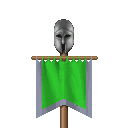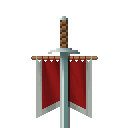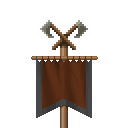Nations of the Late Ages
The Late Ages (also known as the Late Age, or LA) is the Third of Three eras that one can set their Ascension War in. For the most part, the greatness of the Middle Ages has been relegated to history, while the legends of the Early Ages are either fairy tales or completely forgotten. Civilization has continued to progress, and life has materially improved for most people. On the other hand, magic has declined somewhat, and many of the twenty-six nations in this game have taken a darker path, either to try something new or to regain the glory of the past.
Late-Age Arcoscephale is themed after the successor-states of Alexander the Great, such as Antigonid Macedon and the Seleucid Empire. The Arcoscephale of the Middle Ages no longer exists, having declined after the death of its finest leader, the Great Conqueror (Alexander himself). However, the Arcoscephalian culture he spread still remains, with new concepts added to it from the conquered peoples. Among these new things is pantheism; according to the Sibyls and other Mage-Priestesses, all Pretenders are true gods, but they're also meant to serve the Arcoscephalian "Master of All". Thus, foreign Temples can be reworked by a Priestess instead of being razed, saving their Master a pretty penny.
Late-Age Pythium is modeled after the Late Eastern Roman Empire, partially with its Late Imperial Legions (which were also used by the early Byzantines) but most-definitely with its religious situation. You see, the state religion of the Middle Ages was a glorious, Heaven-focused, Eastern-Orthodox-themed faith; that faith has been sidelined in favor of mystery cults, however, such as the C'tissian-idolizing Serpent Cult. Other cults based on the Mithraic, Eleusinian, Dionysian, and Isis Mysteries can be found in the Empire, but only the Serpent Cult (and the old religion's state Priests) can spread the Pythian God's Dominion. The other cults produce weak-but-useful mystics that have their own disturbingly-effective rituals.
Sceleria is DEAD! At least it out-"lived" Ermor, its parent-state and its undead shame. They didn't beat it themselves, though, and they even repeated its terminal mistake. You see, after Ermor was stopped, Sceleria's commoners got over their fear of skeletons, and the skeleton-reanimating Mage-Priests of the Death Cult were petitioned to till the fields with their puppets. The Mage-Priests had no interest in Death anymore, since their cross to bear (causing Ermor's Undeath) had been lifted, so they ultimately decided to open a Soul Gate to the Underworld. They were hoping that the souls of Ermor & Sceleria's deceased would love to return to work in the land of the living… let's just say they were partially right.
Man is about as mundane as a high-fantasy feudal Kingdom can get, especially in Dominions. It wasn't always as mundane as it is now, though; the Kingdom was practically built by a coven of Witches, who discovered the arts of a vanquished race of "elves" and used them to empower their Magic. With the apparent final death of the "elves" (though correlation doesn't necessarily imply causation) came a Curse on this Magic, however, salting the land with Magic and Misfortune wherever it was used. The King forsook his title's original benefactors for the sake of the country, and now sponsors universities in the capital to replace the Old Magic with something safer. Man's army loves ranged weapons, by the way.
Ulm is a spooky Kingdom, with heavy German-Gothic influences from Bavaria and Prussia. Founded shortly before the Middle Ages, the "Iron" Kingdom hadn't been truly tried-and-tested until near the end of that period, when it was wracked with a series of civil wars. The worst of these ended with the Night of Treason and the Malediction laid on the land in that fateful night, which made many soldiers and nobles thirst for blood. Magic outside of religion was banned the following day, and the last Smiths that could make Ulm's trademark Blacksteel were purged by their inquisitorial rivals. The Kingdom still lacks the power to fully enforce the ban & clean itself up, which is nice if you like Vampire Lords and the Illuminati.
Marignon is a Spanish-themed Kingdom, and about as close to modern-day technology as it can get (pre-gunpowder). Born from the ashes of Ermor, it accomplished its great crusade for survival at the end of the Middle Ages by destroying the Undead menace. This took everything the Kingdom had, however – well, actually, it took more than the Kingdom had, so now Marignon has a debt that it can never repay. That debt is owed to Hell itself, but the Lords of the Inferno are easier to bargain with than mindless Undead Legions. Even now, Marignon is somewhat-reliant on Devils, since its Knights died fighting Ermor and the urgency for new ones to enlist is gone. It can now pick out weaker foes overseas, however, which is nice.
There was a time when this Aztec-themed Empire wasn't a chaotic, Human-sacrificing hellhole. That time has passed, ushered out by Atlantians who fled the collapse of their own Kingdom of Coral. Seeing that the Rain was one aspect of Mictlan's deity, the Atlantian Kings demonstrated their Water Magic to the isolated Empire, and rebranded as Kings of the Rain Priesthood. In the temple they now work at, the "Kings of Rain" have found and reimplemented the practices of the Blood Cult of the Early Ages, regressing the Empire in an effort to gather enough Magic power to retake the seas. They probably didn't understand that Blood Magic is totally unusable underwater, or that Mictlan's deity has a major addiction to Blood.
The Celestial Empire, in the Late Ages, has been terrorized by Mongol-themed barbarian nomads. The Imperial Family has been deposed, and the Bureaucracy has crumbled. The invasions appear to have recently ceased, however. The ruling Khans, or "Barbarian Kings", have brought ancestor worship back to the Empire after an entire era of its absence; their Mage-Priests have deduced that the best way to understand the already-dead is to be close to death yourself, so all of them are incredibly old, though terrifyingly-fit for their age. The Barbarians' (and T'ien Ch'i's) best troops are excellent Horse Archers that let the spirits guide all of their attacks.









Jomon is a nice, arable region, at least relative to neighboring Shinuyama. It's no surprise that Shinuyama's Bakemono Kings conquered Jomon first in the Middle Ages, subjugating the Human residents to their chaotic whims. By the end of those Ages, the Humans had had enough of chaos and disorder; after revolting, they established a strict feudal hierarchy in the lands they had control of, with the mercenary Samurai as their nobility. Jomon is also quite isolated from other civilizations, especially since T'ien Ch'i's collapse; much of its technology, and even its Magic, is thus stuck in the Middle Ages or earlier. Many powerful Magic beings seem to like this quiet feudal realm, though, including "gods" & sea Dragons!
Agartha is a subterranean realm, populated by Humans who revere the remains of the previous inhabitants. It's currently led by the Ktonians, Mages "of the Earth" (assuming Ktonian is a corruption of the Greek "Chthonian") who inherited the Magical secrets of the Oracles that led the previous inhabitants, though a few are Alchemists who fled Ulm's ban on Magic. Being irreplaceable, the mummified predecessors are tended to with utmost care, and only the finest Ktonian Necromancers are trusted with "reawakening" them. Everything else in Agartha is used to its fullest extent, however, including Cave Drakes and Human remains.
Abysia is a theocracy of lava-men on the decline. When Malphas, the Fiendish Early-Age architect of Abysia's traditions with Blood, set out to corrupt and destroy the Abysian people, he was playing the long game. The ruin of Abysia came, not from a disloyal army of Demonbreds rising against the nation, but from the still-loyal hordes of Humanbreds breeding the "pure-blooded" Abysians out of it. This has coincided with Abysia's volcanic heart (which once made Abysia hot enough for the "pure-bloods" to be happy) cooling, though centuries of dumping Blood Sacrifices into it might have done the job instead of "the dilution of the Pure Blood". The "pure-bloods" have veered deeper into cruelty & dark magic ever since.
Caelum is nominally a "magocracy", though it's apparently led by whoever can strongarm the other Caelian Clans into compliance. In the Late Ages, the heads are the Raptor bros; they were exiled from Caelum during the Middle Ages due to an issue between their Harab Seraphs (Mage-Leaders) and the Seraphs of the Airya Clan, but a new God rallied them to return home by the end of those Ages. Thus, the black sheep of the Caelian Clans returned with iron and "grounded" practices, and the lofty Airyans were scattered like dust around a Titan's footstep. The demons that the Raptor bros' ancestors once served would be proud, especially since the purged Raptors' ghosts have tempted the new Elders to re-Summon them.
C'tis is an Egyptian-themed Priestly Kingdom of only-herbivorous lizardfolk – the carnivorous ones were all expelled, after a particularly-nasty slave revolt assisted by semi-divine crocodilian Giants known as the Sobek. At around the same time as this revolt, the Sacred Swamps of C'tis started to turn to desert, and the Marshmaster fad of the Middle Ages has now lapsed into history. While the Marshmasters had risen as a sort of denial of Death after Ermor's Undeath, other Sauromancers (C'tissian wizards) rallied in the tombs of previous administrations in response to the disaster; perfecting the ancient art of reanimation in secret, these Sauromancers have now returned with a new God and old Kings.
Times have changed, even for Pangaea. At first, civilization was firmly rejected by the halfmen of the woods, but some had begun to adopt its fruits by the Middle Ages. In the Late Ages, steel, trade, and other Human curiosities have encouraged those convinced of civilization's power to assume it for themselves. The Centaurs now hold lordships, and the matriarchs of the Old Faith have become sacred soldiers in an effort to try and catch up to them in importance, leaving the Sacred Groves to the Panii and Minotaurs. The halfmen still revere Nature, but with violent protectors instead of gentle caretakers, the Sacred Groves have started to wither. Even Pangaea's new God is semi-civilized, much to the Panii's chagrin.
Midgård is the Norse-themed realm of Mankind. Before the Late Ages, however, it was called Vanheim, as the homeland of a race of "elves" known as the Vanir. Naturally strong and gifted with Magic, the Vanir once treated Humans as lesser beings; however, they busied themselves with fighting other races, and dwindled in number while Human tribes migrated to their Magical lands. Though the Vanir are still sacred and their Vanjarls still carry great influence, Human Jarls, Mages, and Priests have already begun to take their place. Among the Mages are the Völvor, seeresses who assist the Vanjarls with their fortune-telling, and the Galdermen, Skinshifters who learned Magic after being given lycanthropy by the Vanir.










Named after the "Outyard" of a Giants' stronghold in Norse mythology, Utgård was once called Jotunheim, as the homeland of the Jotun Giants. The name-change came with the arrival of Mankind, who hadn't ventured into the frozen lands until relatively-recently. Their arrival coincided with a stark decline in the Jotun population, and the Jotun Jarls saw them as potentially-useful allies. Offering the alliance against their Gygja advisors' wishes, the Humans accepted, and the Gygjas and their Vaettir servants eventually left the realm in disgust. At Utgård's heart is the Magical Well of Urd; here, Human (female) Seithkonur known as the Nornir divine and weave the fates of both Men and Giants.
Bogarus is a Russian-themed patchwork of Principalities, with each one being a piece of old Vanarus. The disintegration happened shortly after the last of Vanarus's Vanjarls passed, along with the name-change. The only unifying principle for the Princes is religion, which hadn't actively tried unifying them before the Church's recent Reformation at its God's request; because of this, each city in Bogarus has different laws, and each Prince has a different list of Magic traditions practiced in their palace. Some Mages actively pursue outlandish goals with Princely backing, such as mapping the future or finding the "true" names of things, while others use dark powers to scam their sponsors. Flagellants are common, too.














Patala is the cavernous Netherworld from which all rivers spring. It's home to the Nagas, semi-divine serpentine beings who can hypnotize with a passing glance. They were first summoned to the surface back in the Middle Ages, by a Kingdom of civilized apes known as the Bandar Log, and it didn't take much for them to seduce their summoners; their preferred form for walking under the Sun matches that of the Bandar Log's Early-Age living gods, after all. This isn't a true return to form for the Bandar Log, however; their new masters are found only in Patala Proper and similar environments (province-sized caves), while the "old gods" could be found and recruited anywhere with a Fort and a Temple.









Gath is the last City of Giants in what was once Hinnom; all others have been either destroyed by Abysia or ruined by an excess of Humans. The land is in a better state than it was in the Middle Ages, thanks to the austerity of the Anakim and their Rephaim subjects, but the Gittites themselves are far smaller and weaker than their ancestors; only a scarce few demonstrate even a hint of the Anakim's power. Still, they are bigger and stronger than Humans, and have therefore subjugated several Human tribes around their city, including eight of the twelve Tribes of Israel. The last of the Anakim have adopted their distant ancestors' Bloody practices out of desparation, and have found Human Blood to be satisfactory.











Ragha is a Persian-themed melting pot; first it was held by Gath, then Human immigrants "ruined" it, then Abysia conquered it, and now Airyan Caelians have settled on it. The Shahdom was cleft from Abysia during Arcoscephale's Great Conqueror's war with the lava-men, and it would've been part of Caelum if Caelum weren't currently run by the Raptor bros. The two peoples of Ragha are in a strange alliance; they despise each other, primarily because the local Abysians worship the same demons as the Raptor bros and still mix Fire with Death and Blood, but they need each other in order to remain independent. When it's Cold, the Iceclads do better and the Airyans take charge. When it's Hot, the Abysians lead. When it's only Temperate, only the apolitical peasants are happy.








Xibalba is a Mayan-themed subterranean realm inhabited by two races. Its original natives are the Zotz, bat-people who once served Underworld "gods" before the Pantokrator tasked them with guiding the Sun. In the Middle Ages, Atlantians literally flooded in, becoming a toad-like race known as the Muuch, and replaced the Zotz of the depths. At the height of their power, most of the Muuch attempted to conquer the surface world, only for Mictlan to rout them so badly that only their Kings made it back home. The Kings slept on their failure, and the caverns dried up during their torpor. Now the Zotz have returned from their forest exile, but they now worship and serve the reawakening Muuch Kings as Water "gods".







Phlegra is a Spartan-themed Kingdom. It was once led by the Gigantes, Giants that once declared War on the Gods, but the Gigantes were cursed for their hubris and degenerated into insane Tyrants. The Tyrants destroyed each other, and the last of them fell asleep under Phlegra's mountains, but not before handing power to the Younger Cyclopes in order to crush a premature slave revolt. Phlegra's religion is centered entirely around hoping beyond hope that the Tyrants never awaken, since nothing on Earth could restrain them. Behind the scenes, Human scholars that were brought in to compensate for the Tyrants' declining intelligence have built up power through imposing Magical enslavement on their peers.

The Tyrants have ![]() 4
4![]() 3
3![]() 2!
2!



Vaettiheim is the homeland of the Vaettir, tiny Goblins of the north. Until relatively-recently it was part of Jotunheim, for the Vaettir had been seduced by the Jotun Gygjas and their Seith sorcery back in the Middle Ages. When the Jotun Jarls allied with the Humans, who were pawns of the enemy Vanir in Ages past, cracks began to form in the united Jotun realm, culminating in a rebellion of the Gygjas that was forseen by the Nornir and crushed. The Gygjas retreated to the Iron Wood with their few remaining Jotun allies, and the Vaettir circled the wagons around their Giant idols. Some (female) Vaettir have been encouraged to enter the Iron Wood, so that the Gygjas may groom successors and keep their grudge eternal.










The Atlantis of the Seas is no more, having fallen to R'lyeh at the end of the Middle Ages. All that takes its current name is an Inuit-themed settlement of the survivors (that didn't arrive at Mictlan). Their refuge is the Foresaken Coast, so inhospitable that not even decomposers can survive here; the Atlantians here met with an Awakening God that would agree to lead them back into the Sea if they served as its Priests, and the rest has yet to happen. This Atlantis is relatively young, for the only Atlantians here that have grown larger than a Human are still traumatized by the fall of their undersea home. Their children can use Ice-crafted equipment quite comfortably, while they themselves stick to furs & bone gear.
When R'lyeh conquered their neighbors under the sea, they did so with the help of the Void, the space between and beyond the Spheres. The bit of their planet that they arrived in came with a Void Gate, a hole in the Veil of space, and they used that hole to beckon beasts beyond our understanding. The Illithids got so much mileage out of it that at one point they figured that they were Masters of the Void; the Void simply laughed at that notion, and this was enough to crush their Empire of brainwashed slaves. It took the strongest Illithid minds to reassemble some measure of normalcy, but by then the Void had already claimed their God. All dreams in R'lyeh's Dominion are now tainted, causing potentially-lethal madness.








Erytheia, The Red Land, is a Merman Kingdom that takes after Ptolemaic Egypt. It's the fusion of an Arcoscephalian colony with a Pelagian colony, set free by the collapse of both Middle-Age Kingdoms; Arcoscephale collapsed due to the political upheaval following the Great Conqueror's death, of course, but Pelagia fell apart when the Triton Kings entered an eternal slumber with the Dreams of R'lyeh. The Erytheian King, eternally (thanks to incest) of pure royal Merman blood, styles himself as "King of Both Worlds"; The remaining Triton nobles wish he'd acknowledge the Ocean "world" a bit more often, though, since they can't make Magic Items for going on land and visiting the neglectful monarch.










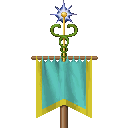
 1
1





































 2
2


























 1
1









 1
1
 Heat 1
Heat 1








 1
1























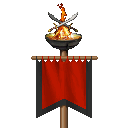














 Cold 1
Cold 1


















